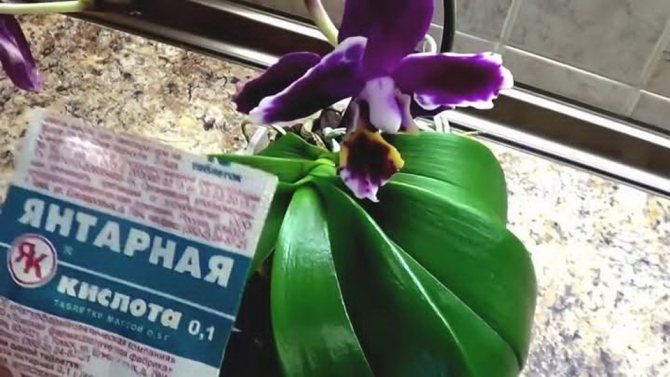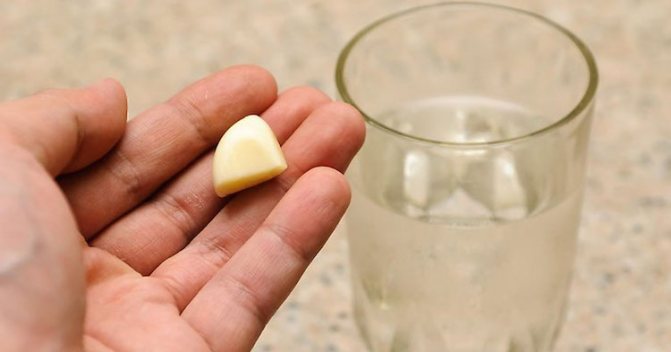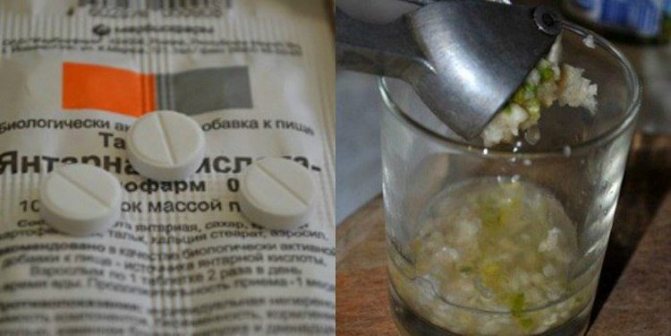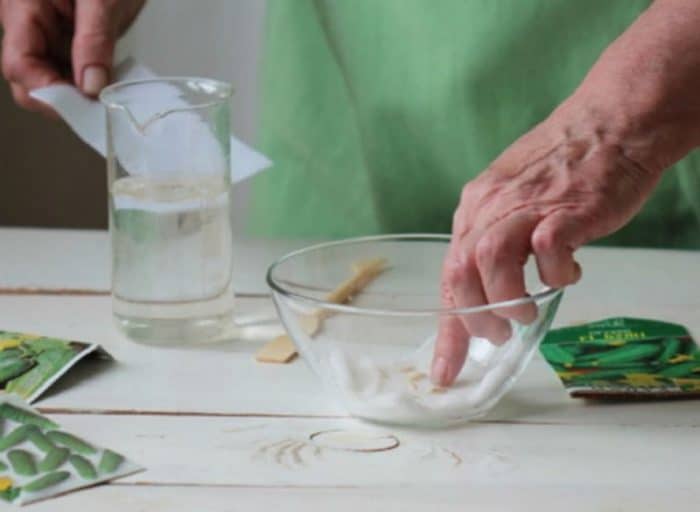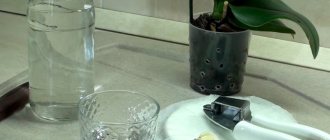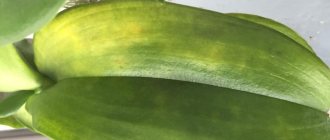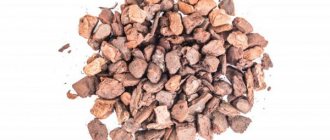Succinic acid for orchids is used for various purposes. These white tablets, which are ground into powder and then dissolved in water, are used to feed indoor orchids, revive plants and fertilize. It is necessary to use this drug correctly so as not to harm the flower, therefore it is very important to follow the instructions and dosage. There are many questions associated with this drug. You can find the answers in this article. You can also watch a video that describes the process of reanimating an orchid.
Ideal food for orchids
Succinic acid is a colorless crystalline substance that is completely soluble in alcohol and water. Under natural conditions, this compound is found in amber, brown coal and living organisms. You can buy tablets or succinic acid powder at any pharmacy. It is widely used in floriculture for the treatment of orchids (especially phalaenopsis).

Succinic acid is a universal helper for orchid growers
The popularity of succinic acid is due to the many beneficial effects it has on plants. These include:
- resuscitation after stress, for example, transportation or transplant;
- activation of the rooting process of cuttings;
- an increase in the duration of flowering;
- stimulation of root formation;
- acceleration of the regeneration of stems and leaves affected by high temperatures or frostbite;
- increasing resistance to adverse factors - sunburn, lack of watering, frost, waterlogging;
- saturation of leaves with chlorophyll, which increases the intensity of growth.
In addition to the positive effect on the plants themselves, succinic acid also improves the quality of the soil. It improves microflora, promotes the destruction of toxic substances, accelerates the processing and absorption of other fertilizers by orchids.
Important! With proper use, no harmful effects of acid on plants have been identified.
Resuscitation of orchids without roots
If the roots of the plant have died, then you can reanimate the orchid as follows:
- remove all rot;
- treat the cut with activated carbon powder;
- place the plant in a solution of succinic acid in a glass container;
- put on a windowsill that is well lit, but does not fall under the direct rays of the sun;
- the succinic acid solution is renewed every 3 days.
New roots will appear in 2 - 3 months. After the roots grow 5 cm, the plant is planted in a substrate.
How to prepare a solution: proportions and nuances
Succinic acid is available in powder form or in the form of tablets. The method of preparation of the solution depends on the form of the preparation..
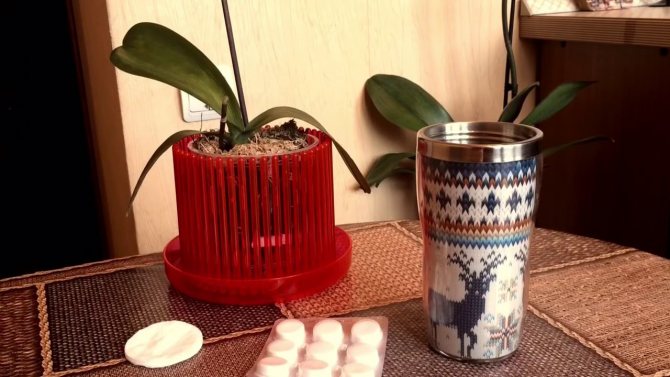

Succinic acid is easily absorbed by the plant
When using tablets, you need to dilute 1 piece in 1 liter of water at room temperature. But this should be done in stages:
- First, the tablet is diluted in 200 ml of liquid.
- After complete dissolution, add the missing amount of water.
Powdered acid is diluted at the rate of 1 g per 1 liter. If a suitable scale is not available to determine the amount of preparation required, you can use a conventional knife. You should take so much acid that it fits on the very tip and dissolve in water.
Important! A solution of succinic acid is suitable for use only for two to three days after preparation, then it completely loses its useful properties.
Video: how to dilute succinic acid tablets to water an orchid
Indications for use
Succinic acid strengthens orchids, increasing their resistance to various diseases. Thanks to this substance, plants begin to bloom, as the drug increases the level of chlorophyll. Indications for the use of succinic acid for orchids:
- deterioration in the appearance of the plant;
- the appearance of signs of the disease;
- decay of roots;
- poor growth;
- lack of flowering;
- need for transplant:
- rooting;
- the plant dies.
In these cases, it is recommended to try to improve the condition or save the orchid with succinic acid.
Methods for using succinic acid
For novice flower growers, succinic acid can become a lifesaver in caring for a demanding flower. But in order to get the desired effect, you need to adhere to certain recommendations.
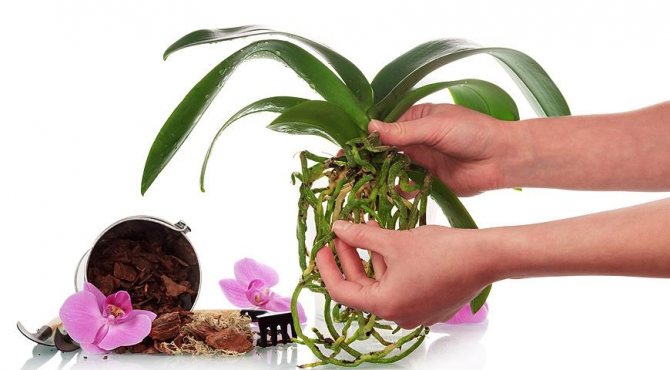

Orchid is a very delicate and demanding flower that is important to nourish correctly.
How to water
Watering orchids growing in the soil with an acid solution is recommended using a small watering can without a spray. The liquid should flow slowly, in the form of a thin stream and gradually fill the entire surface of the soil. When it begins to flow through the bottom holes, watering should be suspended. You need to wait until the excess liquid drains into the pan.
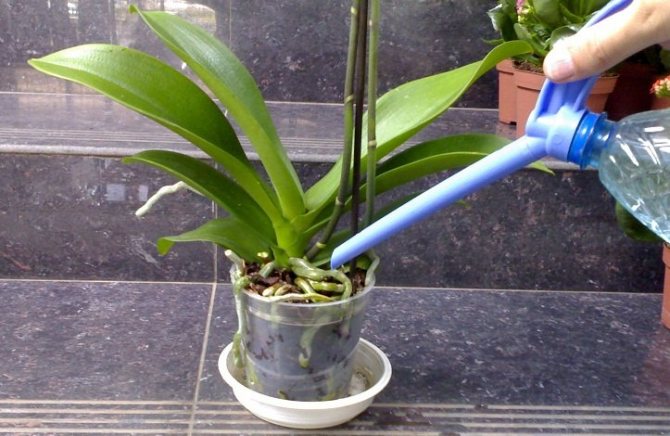

Watering with succinic acid solution is done slowly
Watering an orchid in a container without drainage holes, for example, if the plant is grown in a glass flask, has its own characteristics. It is carried out using the same watering can, but it is important after 15–20 minutes to drain the excess solution as follows: holding the root system and drainage with your palm, tilt the planter and wait for the liquid to drain completely.
If the orchid is located in a place protected from drafts and temperature extremes, watering can be carried out at any time of the day. Otherwise, it is advisable to perform the procedure in the morning, so that the plant dries up in the evening.
How to wipe the leaves
To process orchid leaves, soak a piece of cotton cloth or cotton pad in the solution and wipe. In this case, acid should be avoided in the base of the plates.... In this case, the solution may not be noticed and, accordingly, not removed in due time.
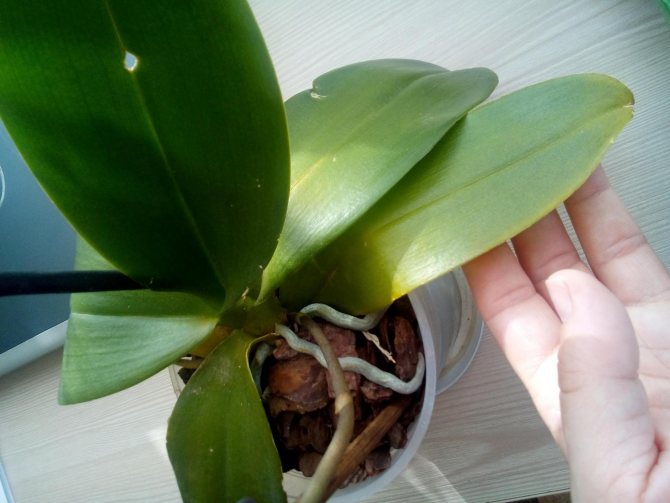

When wiping an orchid, it is important to avoid getting acid on the base of the leaves.
Important! Do not leave acid on the leaves for more than two days. It becomes useless for the plant.
In order to remove the drug, the plates are wiped with napkins dipped in ordinary water at room temperature.
Video: master class on wiping orchid leaves
Features of application for the growth of the root system
Phalaenopsis orchid processing, as a rule, occurs before its transplant. The procedure is carried out by soaking the roots in a solution, while the holding time varies. If the case is critical and the plant needs urgent restoration, then the flower should be left in the composition for 2–2.5 hours. For a healthy orchid, half an hour processing is enough..


Root treatment activates their growth
After soaking, the roots must be thoroughly air-dried. Only after that you can start transplanting to another container. Experienced flower growers note that the result can be observed within a week - root growth is activated, new shoots are quickly formed on the peduncles.
Video: we process phalaenopsis with amber fertilizer
How to revive an orchid without roots
Florists are familiar with the situation when an orchid loses the bulk of its roots as a result of inappropriate care. To save the plant, its shoots and leaves are sprayed with a concentrated solution of succinic acid - 4 tablets per 1 liter... It is better to carry out the procedure daily in the morning. For spraying, it is recommended to use a spray bottle with a fine nozzle so that the liquid is well dispersed. Do not be afraid of an overdose, the flower will take exactly as much as it needs. For greater effectiveness, wipe the leaves with a damp cloth every day before the procedure, and then apply a fresh composition.
Young shoots are especially in need of spraying with succinic acid, the solution helps to stimulate their growth.
There is also a less troublesome method - immersing the plant without a root directly into the solution. Spraying the leaves with this fertilizer in addition to this option is not recommended.
Procedure:
- Dilute the nutrient composition in the same dosage as for spraying - 4 tablets per liter of water.
- Place the phalaenopsis in a transparent container so that only the outlet is immersed in water.
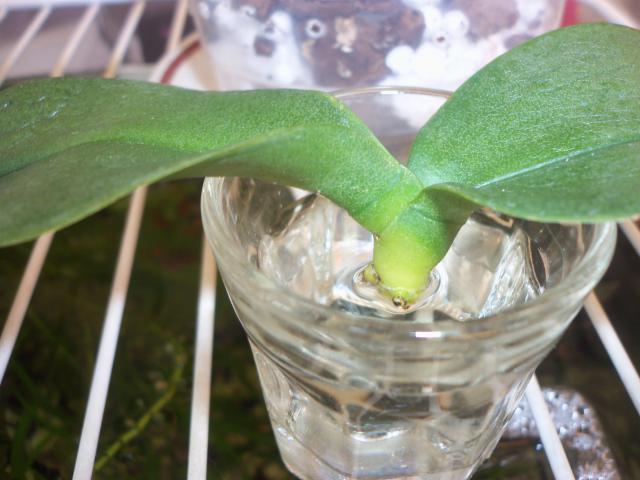

Only the root collar of the plant should be placed in the solution.
- Fix the orchid in this position and provide it with a comfortable environment: place it in a well-lit place, but without direct sun exposure.
- Keep the room humid and warm during resuscitation.
- Add fresh solution as it evaporates and is absorbed by the plant (the whole procedure is performed until the roots appear). Since succinic acid retains its beneficial properties for 2-3 days, regular replenishment of the vessel with freshly prepared fertilizer will create the most comfortable conditions for the flower.
- After 2-3 months, the reanimated flower will give new roots.
- When they reach 5 cm in length, the plant can be transplanted according to the rules in a permanent pot.
Another way to help a flower grow roots is as follows:
- Two or three tablets of succinic acid must be crushed into powder.
- Coat the orchid stalk with this substance.
- Then place the plant in a transparent container with ventilation holes and the usual substrate for an orchid.
- Until the roots appear, watering is partially replaced by spraying the leaves.
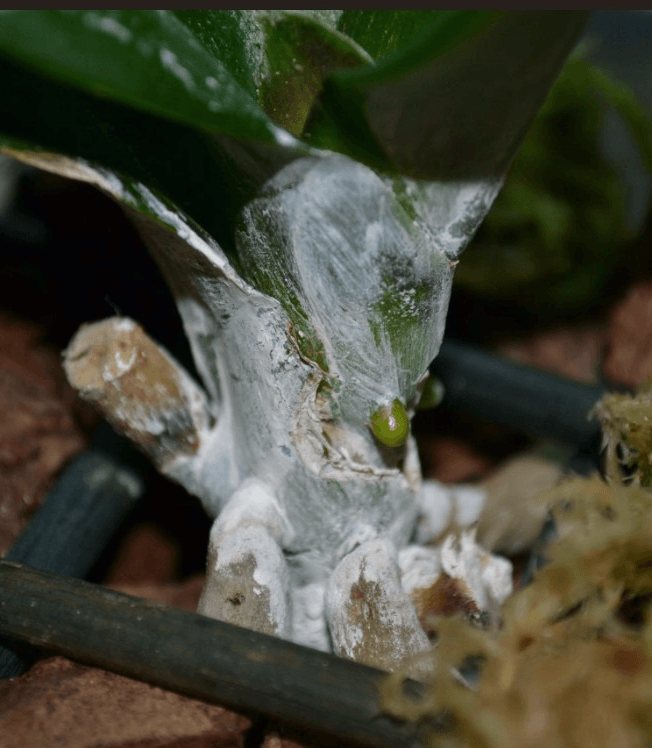

Succinic acid is an excellent helper for growing new flower roots
Video: master class on orchid processing for root resuscitation
Principles and methods of using the product
For the recovery of diseased orchids, succinic acid is one of the most popular remedies. Even healthy flowers respond well to acid feeding, which helps them maintain a beautiful decorative appearance and affects growth and flowering. With the systematic addition of dietary supplements, orchids rarely get sick, they bloom actively and profusely.
Leaf processing
Wipe the leaves with a sponge or cotton swab dipped in the solution (including the bottom of the leaf plate). You can spray the green mass of the plant, avoiding pouring liquid into the growing point.
Spraying orchids with succinic acid provides the following effect:
- disposal and protection from ticks and other insects;
- disease prevention;
- formation of resistance to climate change;
- growth stimulation;
- acceleration of the appearance of peduncles;
- increased flowering time.
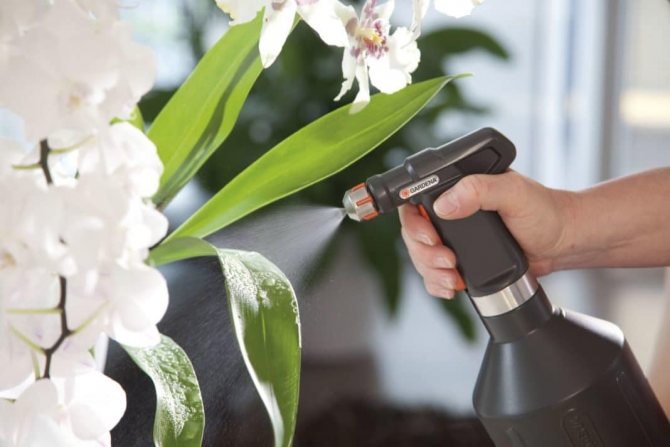

Spraying orchids with succinic acid
Healthy plants are sprayed with the prepared solution every two to three weeks.
After spraying the orchid, wipe the center of the flower with a dry cotton pad to remove moisture from the outlet.
Watering
Watering orchids with succinic acid is useful for prophylaxis and during treatment. Part of the drug settles on the ground, and even after the excess liquid drains into the pan, it nourishes the roots of the orchid, activating growth and the emergence of new branches. For treatment, the plant is watered for 2 weeks. Orchids are fed with succinic acid once a month.
Root processing
The roots are processed when they are damaged. It is necessary to remove dry roots, if only two or three healthy ones remain, remove them too, especially if the roots look as if they are hanging on a thread, since they can no longer feed the plant. How to remove damaged roots:
- Disinfect scissors.
- Cut off damaged roots.
- Dip the root part in activated carbon powder for disinfection.
- Place the plant in soil so that the plant can grow healing tissue around the cut.
Water every other day. When transplanting, the roots of the plant are placed in a solution of succinic acid for half an hour.
Is there a risk of overdose: how often can acid be used?
Orchids are able to easily assimilate succinic acid. There is practically no chance of an overdose. An excess of a substance is not used by the plant as a food product. However, adherence to certain norms helps to achieve the maximum positive effect.
You can use a solution based on succinic acid in different ways. However, the regularity of use is general. The orchid should be processed once every 20-30 days. It is often impractical to use acid. Flowers simply cannot absorb large amounts of this substance.
Breeding rules
The process of diluting succinic acid is laborious.
Important! The prepared solution should be used in 2-3 days, then it is ineffective.
From pills
To prepare a stimulating agent, take a dense fabric bag (nylon tights in 6 layers).
Step-by-step instruction:
- The substance tablet is put in a bag.
- Hang it in a jar of hot water so that the tablet is completely in the water.
Important! You can not shake the liquid, the product must dissolve on its own.
- After dissolving the tablet, the white opaque liquid is carefully poured into a container so that a sediment remains in the jar.
- The drained matt solution is diluted with water and the plants are treated.
Powder
Powder is easier to work with. It is necessary to dilute 1 g of succinic acid with 1 liter of water.


Advice! 1 g of the product is a powder on the tip of a knife.
How to apply so that the benefits do not become harm
Succinic acid does not pose a serious danger to humans, but if it gets on the mucous membranes or skin, it can provoke irritation. Therefore, it is worth observing safety precautions:
- Gloves must be worn when working with the preparation.
- In case of contact with eyes, rinse immediately with water.
And also allergic reactions and irritation of the respiratory system as a result of acid exposure are not excluded.... In this situation, you need to seek medical help.
In what forms to apply
Pure succinic acid is sold in garden stores. It is believed that in its pure crystalline form, the substance is the most beneficial for orchids.
However, the simplest and most convenient form is tablets or powder sachets, which are sold at the pharmacy.
It's important to know! The pharmacy sells a product that is made for people, so it contains impurities such as ascorbic acid, sugar, glucose, potato starch, talc and others.
In such minimal doses, these impurities cannot harm the plant.
Interesting! One tablet weighing 0.5 g contains 0.1 g of succinic acid.
However, many gardeners believe that the succinic acid tablets are made for the human body. And the plants must be fertilized with special means. Therefore, it is necessary to use succinic acid only in its pure form - crystalline.


Reviews of flower growers about a miracle remedy
I decided to use succinic acid not for its intended purpose, I read on the Internet that it can be fed to the orchid. The fact is that two orchids living on the windowsill in the kitchen have been standing for more than a year and have not bloomed, new leaves and roots have not grown. They seemed to freeze.Then I decided to use succinic acid, I diluted 1 tablet somewhere in a liter of warm water, and soaked my perfumes in this solution for half an hour, rubbed the leaves with the same solution. I did this a couple of times, not really hoping for a result. In the end, I was surprised when one orchid released a peduncle, and the second gave a new leaf and new roots! It turns out that succinic acid really works!
AnnA1988
Of my 15 missing orchids - 12 I managed to save! New leaves and roots got in. I bought store-bought chemicals, but the most amazing effect was all the same succinic acid!
Lucky-Lucky
I bought packs of succinic acid, since it costs only 9 rubles per blister. I strictly followed the advice from the forums: I diluted a tablet per liter of water, soaked pots of orchids in a bath, let the water drain. The rest of the time, zealously sprayed the leaves and roots. Received this water and the rest of the plants (well, why waste?). Defined a control group of 2 orchids, which were photographed after each watering. For 6 weeks of application, unfortunately, I did not see the slightest result. Either I'm doing something wrong, or the method doesn't work, or the orchids are on strike.
marinazar
When using succinic acid, it should be remembered that it has an auxiliary effect. The solution is not a panacea and cannot replace other feeding and care procedures necessary for the orchid. However, it perfectly improves the absorption of nutrients, and also stimulates the development of flowers and plant recovery after the influence of stress factors.
Where and for how much to buy?
You can buy succinic acid at any pharmacy without a prescription. The cost of the drug is 7-9 rubles.
Succinic acid is an excellent food for orchids. Its active components are quickly absorbed by the flower, leading to its active growth. With proper processing, the plant receives reliable protection from diseases and pests. it is only important to strictly observe the dosage and frequency of feeding.
To make your orchid grow well and please you, read about other fertilizers and remedies: Fitoverm, vitamins, Zircon, Epin, Fitosporin, Aktara, Bona Forte, garlic water, cytokinin paste.

